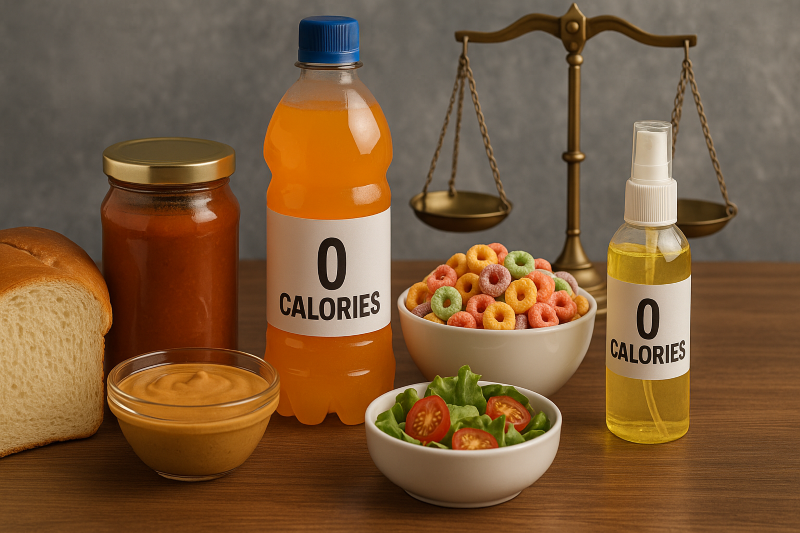
From sugary bread to calorie-free cooking sprays, American food labeling is riddled with loopholes that can mislead even the most health-conscious consumers. Despite efforts by the FDA to make food labels more transparent, manufacturers still find creative ways to hide added sugars and disguise caloric content. This post explores how these loopholes work, the relevant laws that allow them, and what consumers should look out for.
What the Law Says About “Zero Calories”
The key regulation governing food labeling is the Nutrition Labeling and Education Act of 1990 (NLEA), which mandates clear disclosure of ingredients and nutritional values. Under 21 CFR § 101.9(c)(1), if a serving of a food product contains fewer than 5 calories, manufacturers are legally allowed to round that number down to zero.
This rule may seem harmless at first, but it opens the door to misleading claims—particularly in products like cooking sprays. For example, a serving size for spray oils is typically listed as “1/4 second of spray,” an almost impossible-to-measure unit. Because each minuscule spray contains under 5 calories, the label shows 0 calories, even though a typical use of the product could easily add up to 30–50 calories per meal.
The result? Many consumers use these products liberally, believing they’re “calorie-free,” when they’re not.
Added Sugars: Hiding in Plain Sight
Although the NLEA required sugar content to be disclosed, it wasn’t until 2020 that manufacturers were required to list “added sugars” as a separate line item on the Nutrition Facts label. This change was crucial, as many everyday products contain sugars added during processing even in foods where sugar isn’t expected.
Here are some common culprits:
- Bread: Most store-bought breads include added sugar to improve texture and shelf life. For example, King's Hawaiian Rolls contain 5 grams of added sugar per serving.
- Tomato Sauce: While tomatoes have natural sugars, many brands add even more for taste, requiring consumers to check labels carefully.
- Peanut Butter: Natural peanut butter contains no sugar, but major brands often include added sugar and oil for texture.
- Salad Dressings: Often include 5–7 grams of added sugar, especially “light” or “fat-free” varieties.
- Beef Jerky: Surprisingly sweet, many jerky products contain significant amounts of sugar for flavor.
Misleading Marketing: Healthy Image, Sugary Reality
One of the most deceptive practices in the food industry is marketing “healthy” products like Gatorade and breakfast cereals. Many of these items are loaded with sugar, undermining any perceived health benefit. For instance:
- Gatorade (Original): A 20 oz bottle can contain 34 grams of sugar, roughly the same as a can of soda.
- Fruit-Flavored Cereals: Products like Froot Loops can contain 12 grams of sugar per serving, marketed directly to children.
- Salads: Even when healthy ingredients are used, sugary dressings can make them high in calories.
Labeling tricks like using alternative names for sugar such as dextrose, maltose, or high fructose corn syrup—can also confuse consumers trying to eat healthier. If it ends in “-ose,” it’s probably sugar.
Final Thoughts
The FDA has made progress by requiring added sugar labels, but legal loopholes still allow companies to present their products in misleading ways. If you’re trying to make healthier choices, knowing the law and reading food labels closely can make a big difference. Don’t let a “0 calorie” label fool you—many of these products still pack a punch when it comes to added sugars and hidden fats.
All information provided on Silblawfirm.com (hereinafter "website") is provided for informational purposes only, and is not intended to be used for legal advice. Users of this website should not take any actions or refrain from taking any actions based upon content or information on this website. Users of this site should contact a licensed Texas attorney for a full and complete review of their legal issues.
